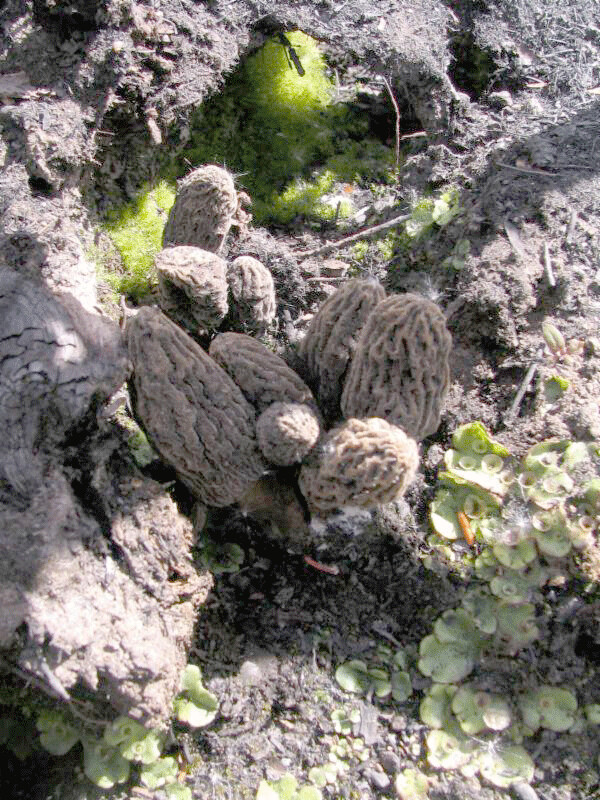News & Articles
Browse all content by date.

The morel mushrooms of summer are here. These charming growths upon the forest floor look like gnomes from a magical land, creatures that would have fabulous stories to tell if only they could talk. But cooking is the only way to hear them. This shouldn't be a problem, because morels are extraordinarily delicious. But too many people are intimidated by them, and don't even give it a shot. And then there are the fearless chefs who add morels to already busy dishes, like a spicy coconut curry or lentil soup, where nobody will taste it.
That kind of attitude will get you in trouble if you're out actually trying to find a morel, a practice that consists of wandering through a burned forest (most commercially harvested morels are from burns), up and over blackened ridges, trying to avoid getting bopped on the head by a standing burned tree, called a widow maker, that may decide to fall. I've been chased by moose, lost, dehydrated, and run out of food, all while hunting mushrooms. Picking them is no picnic.
A measure of caution is surely warranted with morels, both in the field and in the kitchen. The flavor must be coaxed out gently, with butter, onions and wine, and little else.
At first bite the earthly origins are clear. A morel tastes of all things forest, with hints of decaying wood, deer poop, minerals and moss. The story they would tell would be a complex tale, of morel spores everywhere, deep in forest floors, waiting for a fire to sweep through the trees above so they can fruit prolifically on the forest floor. The first wave of morels to grow in a burn are called black morels, which are actually brown. The same burn will usually have another flush later in the summer, filled with the so-called gray morels, which are darker than the blacks, and the stems are double-walled. And then sometimes there will be a third wave of so-called green morels, aka "pickles," which look almost the same as the greys but have three walls. But that is more than anyone but the morel nerds need to know.
Cooked properly, morels are the great outdoors incarnate, wild and bold, like the crew of mushroom pickers I joined in Alaska, in 2006. It was the summer after six million acres burned, along the Taylor Highway between Tok and Chicken. Many of the things that went down at Camp Happy Mosquito, and in the blackened forests, brown rivers and smoky saloons in the vicinity, will have to remain where they occurred in order to protect the guilty. Let's just say that when Jessie finished off a bottle of Yukon Jack and jumped across a roaring fire, in basically the same motion, to choke some dude she didn't like, the conversation barely paused. And when the mushroom buyer from Arizona shot his boat, because it capsized in the Tananariver and spilled five hundred pounds of morels, we all understood the sentiment. And when familiar voices started giggling from the wrong tents, it was time to go picking.
I could probably name the spot, miles upstream from that point, where the crew of Mexican pickers with the red van hiked, after their picker shot the boat. It's where the Frenchman and his posse drove their jet boat, with me aboard, and we found morels as big as rugby balls. But the spot was cleaned out years ago, and trust me, you don't want to go there anyway. You'd be a lot better off asking me where they are now, except I would probably lie, and send you in the opposite direction. Old habits die hard.
So how about this idea instead. Go buy some morels that somebody else picked, ideally straight from the picker, for a taste of wild forest distillate.
Pump some money into an industry that runs on hard work, sweat and risk, and depends on healthy forests-as buying wild salmon supports conservation in coastal watersheds. This time of year, wild morels are available at farmers markets throughout the west, and grocery stores everywhere.
When you have your morels in hand, this is what you should do with them.
Morels
Ingredients
1 cup morels, either whole or sliced. Note: you can stretch out your morel supply by adding regular, button mushrooms to the morels.
¼ cup heavy cream
1 T butter
zest and squeeze of one quarter lemon
½ medium yellow onion, minced
pinch Nutmeg
Salt and pepper to taste
¼ cup dry sherry or white wine
Melt the butter in a heavy bottom pan. Add onion and fungus. Cook together until onions are translucent and the morels start to give up their moisture-about ten minutes. At the slightest hint of a dry pan add sherry, and more butter if it needs it. Add nutmeg, zest and a squeeze of lemon. Cook a moment and add the cream. Cook five more minutes, season with salt and pepper, and serve.
What you serve it with doesn't really matter. You could toss them with noodles or heap them alongside meat or vegetables, or atop a hunk of good bread, which should be involved so that every last drop of sauce can be enjoyed to the max. After all, a lot of ecological processing and human effort went into it.
And when the season ends and we're left with dried morels, they can be easily rehydrated and cooked the same way. Heat up some water or stock, about a quarter cup at a time, and when it starts to simmer pour it on the morels. Toss and cover. If they absorb all of the liquid, repeat, tossing them gently whenever liquid begins to pool. Wait an hour, adding as much liquid as they will take, but not too much.
| Tweet |


